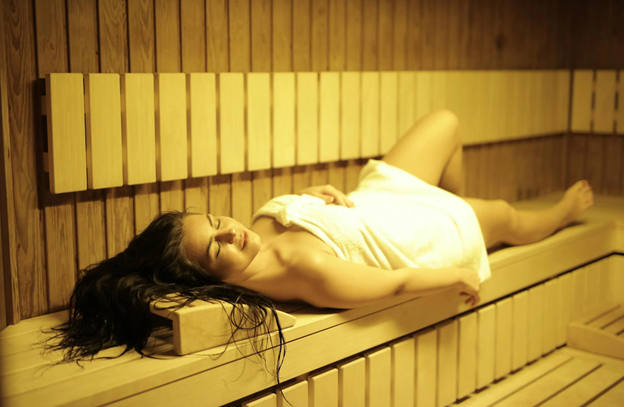Saunas have been used for centuries for relaxation, detoxification, and overall well-being. Today, two primary types dominate the market: traditional saunas and infrared saunas. Each has distinct features, advantages, and drawbacks, and it can all depend on several factors.
The choice depends on different lifestyles, home property sizes, and maintenance preferences. Understanding these differences is essential for selecting the best sauna to fit individual needs, and will help you find the one that fits you.
Traditional Saunas: Features and Benefits
Traditional saunas, often referred to as dry saunas, operate by heating the air within an enclosed space. They typically use a wood-burning or electric stove to generate heat, which can reach temperatures between 150°F and 230°F.
Water can be poured onto heated rocks to create steam, enhancing the sauna experience. The benefits of a traditional sauna include:
- Higher Temperatures
Traditional saunas produce more intense heat, leading to quicker sweating and detoxification. - Customizable Steam Levels
Adding water to heated stones allows for control over humidity and air density. - More Authentic Sauna Experience
Traditional saunas mimic the original Finnish sauna experience, offering a rich and immersive environment. - Faster Heat Penetration
The high temperatures encourage quicker cardiovascular benefits and an efficient sweat response.
However, along with these benefits come some disadvantages:
-
Lower Operating Temperatures
More comfortable for longer sessions, especially for beginners. - Quick Heating Time
Infrared saunas heat up in about 10-15 minutes. - Energy Efficient
They use significantly less electricity than traditional saunas. - Compact and Portable
Ideal for small apartments or homes with limited space. - Deep Tissue Penetration
Infrared heat penetrates the skin more effectively, providing therapeutic benefits like muscle relaxation and improved circulation.
There are several disadvantages too when it comes to infrared saunas:
-
Longer Sessions Required
Lower temperatures mean users may need 30-40 minutes per session to achieve deep sweating. - Less Intense Heat Sensation
Some sauna enthusiasts prefer the high heat of a traditional sauna. - Limited Steam Functionality
Unlike traditional saunas, infrared models do not allow for steam or humidity control.
The Right Sauna: Small Spaces and Urban Homes
For those living in apartments or homes with limited space, an infrared sauna is the better option. These saunas have a smaller footprint, are often plug-and-play, and do not require complex installation.
Traditional saunas, in contrast, take up more space and often require ventilation systems or dedicated outdoor placement.
Best for Busy Lifestyles
If time efficiency is a priority, infrared saunas heat up quickly and allow for shorter session times compared to traditional saunas. Those who prefer an immersive and intense heat session may still opt for traditional saunas but must allocate extra time for heating and usage.
Best for Outdoor Enthusiasts and Sauna Purists
Individuals who enjoy outdoor setups or want a more authentic sauna experience should choose a traditional sauna. Models like barrel saunas or wood-burning options can be set up in backyards, offering a rustic and immersive experience.
Moreover, portable tent-style wood-burning saunas provide flexibility for outdoor and camping use.
Maintenance Considerations
Traditional saunas require regular cleaning due to steam and moisture exposure. If you have a wood-burning model, these require ash cleanup and proper ventilation. For electrical units, they may need occasional servicing for heating elements. Also the wooden interiors need occasional treatment to prevent mold and mildew.
For an infrared sauna, maintenance is easier due to lower moisture levels. They also require occasional cleaning of the infrared panels and wooden surfaces, but the electrical components generally have a long lifespan with minimal servicing needs.
Which Sauna is Ideal For You?
Both traditional and infrared saunas have their advantages, and the ideal choice depends on individual preferences, available space, and lifestyle. Beginners and individuals with limited space may benefit from an infrared sauna due to its ease of use and lower temperature.
Sauna enthusiasts who prefer intense heat and steam should consider a traditional sauna for its authenticity and deeper sweat sessions.
Those with a fast-paced lifestyle may lean toward infrared saunas due to quicker heating times and lower energy costs. Outdoor lovers or individuals seeking a more customizable experience should invest in a traditional sauna, particularly a wood-burning or portable tent sauna.
Ultimately, the decision comes down to personal comfort, budget, and sauna experience goals. Regardless of choice, both types offer significant health benefits, including relaxation, improved circulation, and detoxification, making them excellent investments in overall wellness.
BestBuy Pool Supply Offers both infrared and traditional saunas, and you can choose from their list of offerings depending on your preferences and the factors that are more suitable for you. Visit us now and find the sauna of your choice!

